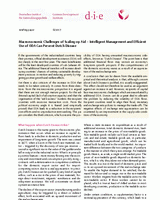Macroeconomic challenges of scaling up aid - intelligent management and efficient use of ODA can prevent Dutch disease
Liebig, Klaus / Ulrike RondorfBriefing Paper 8/2007
Bonn: German Development Institute / Deutsches Institut für Entwicklungspolitik (DIE)
If the governments of the industrialized countries keep their promise, official development assistance (ODA) will rise sharply in the next few years. The main beneficiaries will be the least developed countries of sub-Saharan Africa. The additional financial transfers will increase developing countries’ chances of setting sustainable development processes in motion and reducing poverty by triggering positive growth and welfare effects. Yet there is also criticism of the increase in ODA that needs to be taken seriously. It comes from three directions: from the microeconomic perspective it is argued that there are not enough mature projects for the additional capital (lack of absorptive capacity) and that the organization of the “aid business” burdens the recipient countries with excessive transaction costs. From the political economy angle it is feared (and empirically proved) that ODA leads to a reduction in the recipients’ own efforts and to unproductive rent-seeking. This paper considers the third criticism, which concerns the possibility of ODA having unwanted macroeconomic sideeffects, known as “Dutch Disease”. The point here is that additional financial flows may worsen an economy’s long-term growth prospects if the competitiveness of the domestic economy wanes as a result of an appreciation of the real exchange rate.A conclusion that can be drawn from the available empirical and theoretical analyses is that, although concern about Dutch Disease is justified, it is usually exaggerated. This effect should not therefore be used as an argument against an increase in aid. However, recipients of capital face macroeconomic challenges which are exacerbated by additional ODA. Donors can do a great deal to alleviate the problem by reducing the volatility of ODA flows.Recipient countries need to align their fiscal, monetary and exchange rate policies to manage the trade-offs. The negative effects of exchange rate appreciation can be countered by an improvement in the supply-side conditions of the economy.

